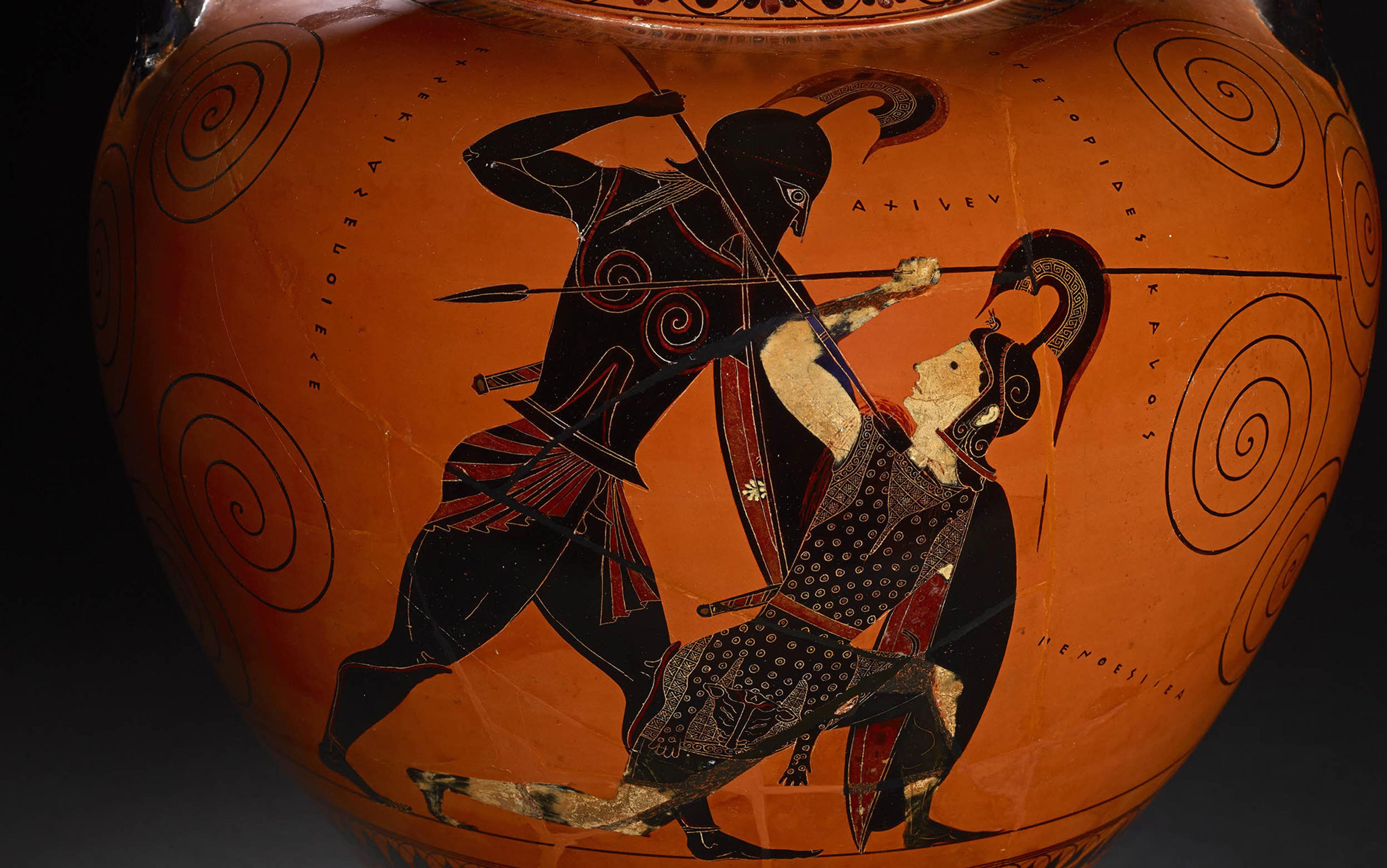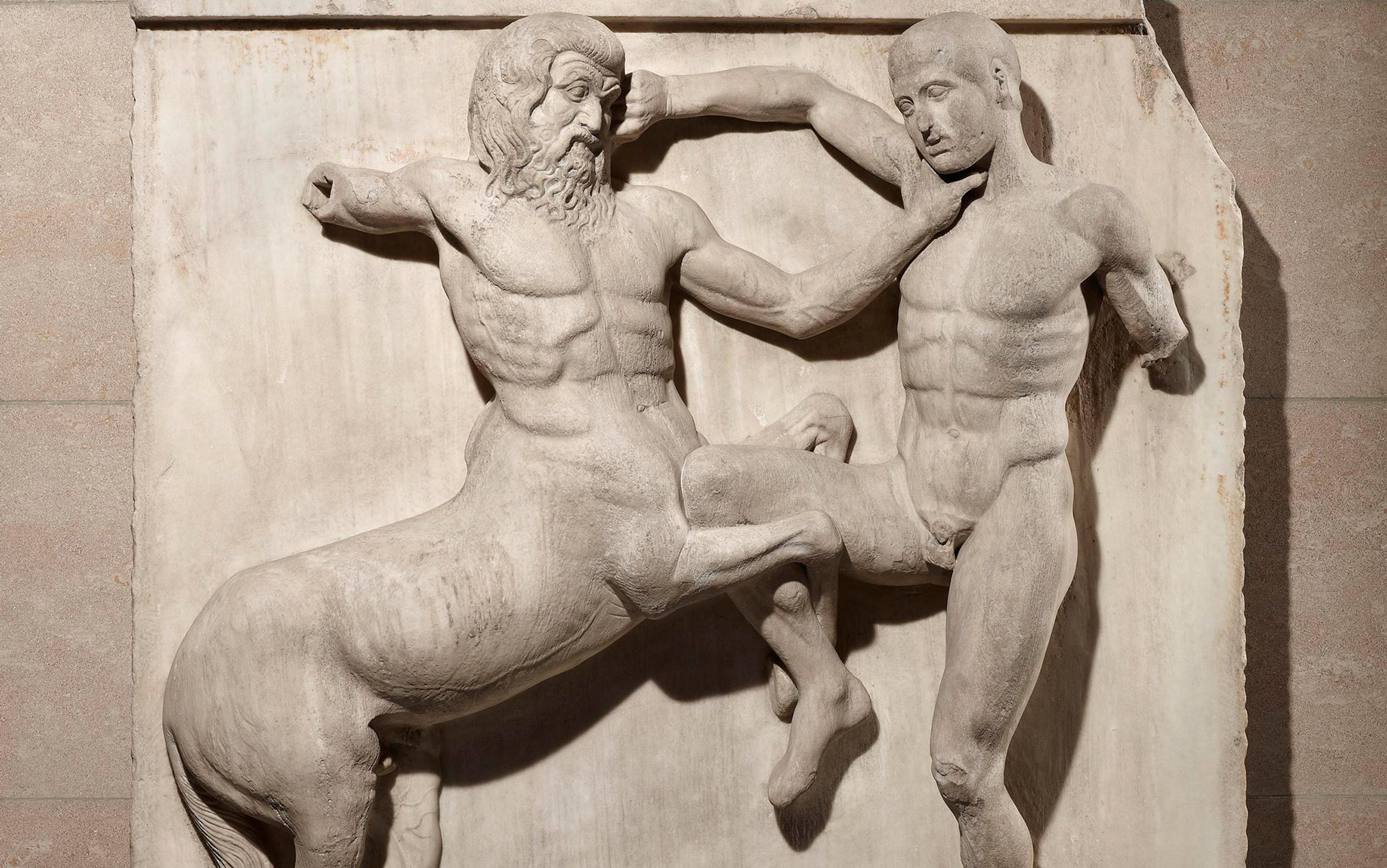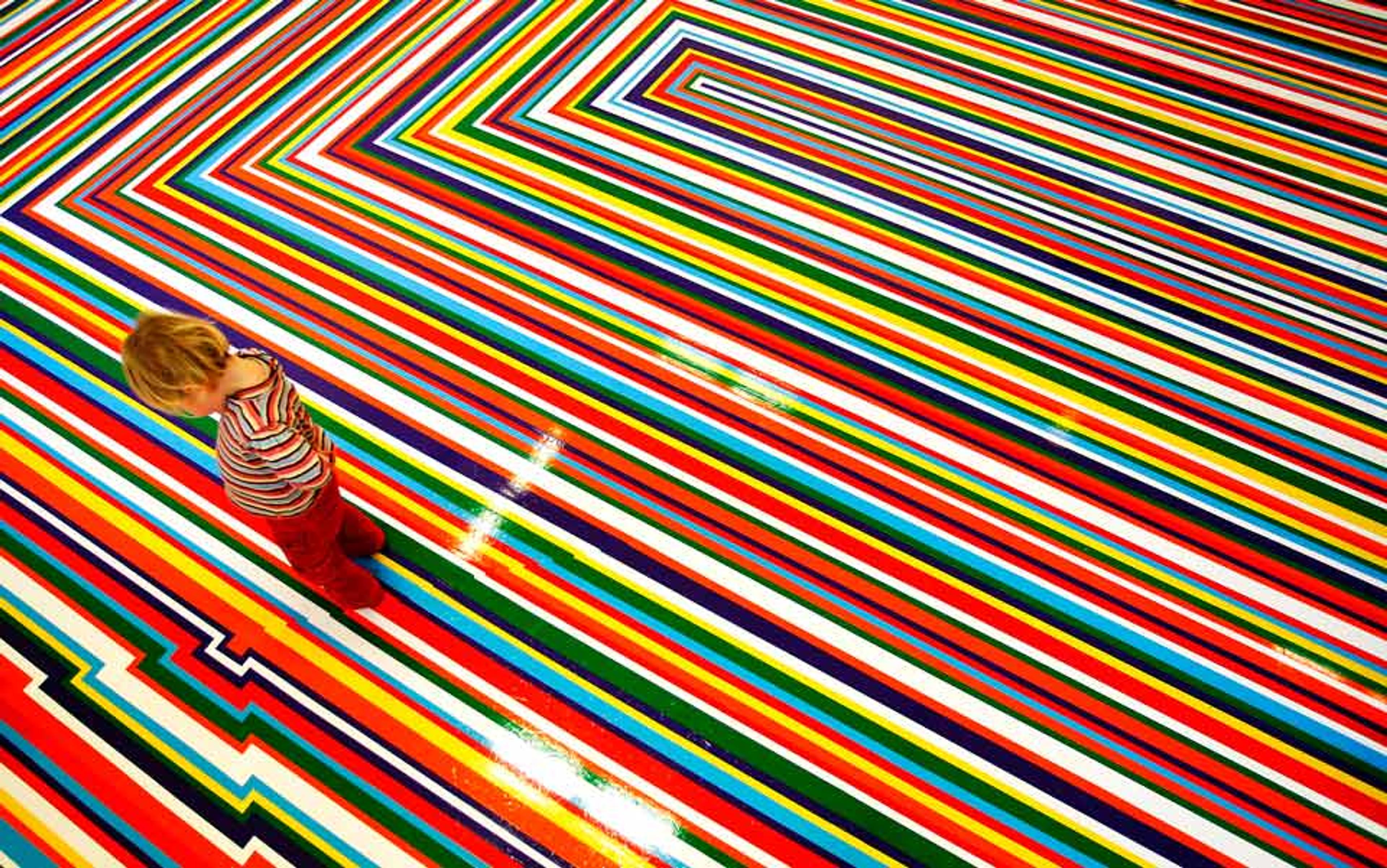Homer used two adjectives to describe aspects of the colour blue: kuaneos, to denote a dark shade of blue merging into black; and glaukos, to describe a sort of ‘blue-grey’, notably used in Athena’s epithet glaukopis, her ‘grey-gleaming eyes’. He describes the sky as big, starry, or of iron or bronze (because of its solid fixity). The tints of a rough sea range from ‘whitish’ (polios) and ‘blue-grey’ (glaukos) to deep blue and almost black (kuaneos, melas). The sea in its calm expanse is said to be ‘pansy-like’ (ioeides), ‘wine-like’ (oinops), or purple (porphureos). But whether sea or sky, it is never just ‘blue’. In fact, within the entirety of ancient Greek literature you cannot find a single pure blue sea or sky.
Yellow, too, seems strangely absent from the Greek lexicon. The simple word xanthos covers the most various shades of yellow, from the shining blond hair of the gods, to amber, to the reddish blaze of fire. Chloros, since it’s related to chloe (grass), suggests the colour green but can also itself convey a vivid yellow, like honey.
The ancient Greek experience of colour does not seem to match our own. In a well-known aphorism, Friedrich Nietzsche captures the strangeness of the Greek colour vocabulary:
How differently the Greeks must have viewed their natural world, since their eyes were blind to blue and green, and they would see instead of the former a deeper brown, and yellow instead of the latter (and for instance they also would use the same word for the colour of dark hair, that of the corn-flower, and that of the southern sea; and again, they would employ exactly the same word for the colour of the greenest plants and of the human skin, of honey and of the yellow resins: so that their greatest painters reproduced the world they lived in only in black, white, red, and yellow).
[My translation]
How is this possible? Did the Greeks really see the colours of the world differently from the way we do?
Johann Wolfgang von Goethe, too, observed these features of Greek chromatic vision. The versatility of xanthos and chloros led him to infer a peculiar fluidity of Greek colour vocabulary. The Greeks, he said, were not interested in defining the different hues. Goethe underpinned his judgment through a careful examination of the theories on vision and colours elaborated by the Greek philosophers, such as Empedocles, Plato and Aristotle, who attributed an active role to the visual organ, equipped with light coming out of the eye and interacting with daylight so as to generate the complete range of colours.
Goethe also noted that ancient colour theorists tended to derive colours from a mixture of black and white, which are placed on the two opposite poles of light and dark, and yet are still called ‘colours’. The ancient conception of black and white as colours – often primary colours – is remarkable when compared with Isaac Newton’s experiments on the decomposition of light by refraction through a prism. The common view today is that white light is colourless and arises from the sum of all the hues of the spectrum, whereas black is its absence.
Goethe considered the Newtonian theory to be a mathematical abstraction in contrast with the testimony of the eyes, and thus downright absurd. In fact, he claimed that light is the most simple and homogeneous substance, and the variety of colours arise at the edges where dark and light meet. Goethe set the Greeks’ approach to colour against Newton’s for their having caught the subjective side of colour perception. The Greeks already knew, Goethe wrote, that: ‘If the eye were not Sun-like, it could never see the Sun.’
Today, no one thinks there has been a stage in humanity when some colours were ‘not yet’ being perceived
Another explanation for the apparent oddness of Greek perception came from the eminent politician and Hellenist William Gladstone, who devoted a chapter of his Studies on Homer and the Homeric Age (1858) to ‘perceptions and use of colour’. He too noticed the vagueness of the green and blue designations in Homer, as well as the absence of words covering the centre of the ‘blue’ area. Where Gladstone differed was in taking as normative the Newtonian list of colours (red, orange, yellow, green, blue, indigo, violet). He interpreted the Greeks’ supposed linguistic poverty as deriving from an imperfect discrimination of prismatic colours. The visual organ of the ancients was still in its infancy, hence their strong sensitivity to light rather than hue, and the related inability to clearly distinguish one hue from another. This argument fit well with the post-Darwinian climate of the late 19th century, and came to be widely believed. Indeed, it prompted Nietzsche’s own judgment, and led to a series of investigations that sought to prove that the Greek chromatic categories do not fit in with modern taxonomies.
Today, no one thinks that there has been a stage in the history of humanity when some colours were ‘not yet’ being perceived. But thanks to our modern ‘anthropological gaze’ it is accepted that every culture has its own way of naming and categorising colours. This is not due to varying anatomical structures of the human eye, but to the fact that different ocular areas are stimulated, which triggers different emotional responses, all according to different cultural contexts.
So was Goethe right that the Greek experience of colours is quite peculiar? Yes, he was. There is a specific Greek chromatic culture, just as there is an Egyptian one, an Indian one, a European one, and the like, each of them being reflected in a vocabulary that has its own peculiarity, and not to be measured only by the scientific meter of the Newtonian paradigm. The question then is: how can we hope to understand how the Greeks saw their world?
Let’s begin with the colourimetric system, based on the Color Sphere created in 1898 by an American artist named Albert Henry Munsell. According to this model, any colour sensation can be defined through three interacting aspects: the hue, determined by the position in the Newtonian spectrum, by which we discriminate one colour from another; the value or lightness, ranging from white to black; and the chroma, which corresponds to the purity or saturation of the colour, depending on the wavelength distribution of light. Fire-red and sky-blue are highly saturated, whereas grey is not at all.
Add to these the concept of saliency, that is, the capacity of a colour to catch visual attention, and the defective definition of blue and green that Gladstone interpreted as a symptom of colour-blindness can be explained since the linguistic definition of hue is proportionate to the saliency of a colour. That is why red, the most salient colour, is the first to be defined in terms of hue in any culture (eruthros in Greek), while green and blue are generally first perceived as brightness because they are less salient colours, and are slowly focused as hues later. This means that in some contexts the Greek adjective chloros should be translated as ‘fresh’ instead of ‘green’, or leukos as ‘shining’ rather than ‘white’. The Greeks were perfectly able to perceive the blue tint, but were not particularly interested in describing the blue tone of sky or sea – at least not in the same way as we are, with our modern sensibility.
This model is helpful for describing the different ways in which a chromatic culture can segment the huge range of possible combinations of the three dimensions by privileging one or the other. A culture might emphasise hue or chroma or value, each with varying intensity. And so the Munsell model is useful in that it helps to demonstrate the remarkable Greek predilection for brightness, and the fact that the Greeks experienced colours in degrees of lightness and darkness rather than in terms of hue.
However, the Munsell model doesn’t completely explain how the Greeks perceived colour since it leaves out the richness of the ‘colour event’ – the subjective, felt perspective of colour that Goethe so valued. For the Greeks, colour was a basic unit of information necessary to understanding the world, above all the social world. One’s complexion was a major criterion of social identity, so much so that contrasting light women and dark men was a widespread cliché in Greek literature and iconography, rooted in the prejudice that the pale complexion of women is due to their living in the darkness of the domestic sphere, whereas men are tanned and strengthened by physical exertion and outdoor sports. So the Greek word chroa/chroiá means both the coloured surface of a thing and the colour itself, and is significantly related to chros, which means ‘skin’ and ‘skin colour’. The emotional and ethical values of colour cannot be forgotten in trying to discern Greek chromatic culture.
Homer calls the sea ‘winey’, alluding not so much to the water’s tint as to the shine of the liquid inside a cup
Of use are two further parameters, in addition to the Munsell model and the subjective value of colour. There is the glitter effect of colour, which is produced by the interplay of the texture of the object and the light conditions, and there is the material or technological process by which a certain colour is obtained in the practice of painters and dyers. With these in hand, the full range of Greek colours will come into view – even the notorious ‘curious case’ of porphureos, the chromatic term most difficult to grasp.
Not only does porphureos not correspond to any definite hue, placed as it is on the borderline between red and blue (in Newtonian terms), but it is often applied to objects that do not appear straightforwardly ‘purple’, as in the case of the sea. (The fact that the sea can appear purple at sunset is not sufficient to explain the frequency of this epithet in Greek literature.) When the sea is called porphureos, what is described is a mix of brightness and movement, changing according to the light conditions at different hours of the day and with different weather, which was the aspect of the sea that most attracted Greek sensitivity. This is why Homer calls the sea ‘winey’, which alludes not so much to the wine tint of the water as to the shine of the liquid inside the cups used to drink out of at a symposium. As shown by the naval friezes and the aquatic animals painted inside many drinking vessels, vase painters turned the image around, so that the surface of the drink suggested the waving of the sea. Porphureos conveys this combination of brightness and movement – a chromatic term impossible to understand without considering the glimmer effect.
The material effect of shimmering under the light rays is well-caught by Aristotle within a discussion on the colours of the rainbow (one of them being violet). In his Meteorology, he states:
The same effect [as in the rainbow] can also be seen in dyes: for there is an indescribable difference in the appearance of the colours in woven and embroidered materials when they are differently arranged; for instance, purple is quite different on a white or a black background, and variations of light can make a similar difference. So embroiderers say they often make mistakes in their colours when they work by lamplight, picking out one colour in mistake for another.
The luminous quality of purple textiles is due to the particular manufacturing of porphura, the material from which the dye was drawn. Purple dye was produced as early as 1200 BCE in Phoenicia from urine, sea water, and ink from the bladder of murex snails. To extract the snails, the shells were put in a vat where their putrefying bodies excreted a yellowish liquid that would be boiled (the verb porphurō means ‘swirling’ besides ‘growing/dying purple’). Various nuances from yellow to green, to blue, to red could be obtained, depending on how much water was added and when the boiling process was stopped. The red and purple tones were greatly prized in antiquity because of the costliness of the process (one mollusc providing just a few drops of undiluted juice) and the colour did not easily fade – on the contrary, it became brighter with weathering and sunlight. This is why purple was associated throughout antiquity – and beyond – with power, prestige and glorious beauty, worn for centuries by Emperors and kings, cardinals and Popes.
So the curious case of porphura shows how the effects of movement, variation and luminosity went along with resonances of preciousness. (Gold was also appreciated for similar reasons, and it is not by chance that the heroes and gods from Homer to Philostratus are often attired in gold and porphura.) By moving beyond the Newtonian model, a clearer picture of the Greek chromatic world emerges. However, there is one lingering question about the Greek perception of colour: why, after all, did the Greeks value brightness so much? The philosophers that inspired Goethe offer a clue.
The first pre-Socratic philosopher to mention colour was Parmenides, who wrote in the fifth century BCE that ‘changing place and altering in bright colour’ are among the characteristics that mortals ascribe to reality, ‘trusting them to be true’. Then came Empedocles, with a fragment that compares the mixing of the four elements that build the sensible world to the work that painters do when mixing different pigments in variable proportions:
As when painters decorate votive offerings –
men through cunning well-taught in their skill –
who when they take the many-coloured pigments in their hands,
mixing in harmony more of these and less of those,
out of them they produce shapes similar to all things,
creating trees and men and women
and beasts and birds and fishes nurtured in water
and long-lived gods highest in honours
The effect of splendour was likely important to Empedocles’ concept of colour, as he explained the production of all colours through the mixture of two elements, fire and water, which correspond respectively to white (light) and black (darkness), and are considered the two extremes in the chromatic continuum.
Plato’s list of primary colours includes white, black, red, and the ‘brilliant and shining’ – to us, not a colour at all
During the second half of the fifth century BCE, Democritus argued that the nature of colours depends on the interaction between visual rays, daylight and the atomic structure of objects. He considered brilliance to be a factor as important as hue for defining colours. Moreover, in explaining the various colours as mixtures of a basic set of four (white, black, red and green), or as mixtures of the primary mixtures, he considered the mixture of red and white (corresponding to the golden and copper-colour) plus a small amount of green (adding a sense of freshness and life) to give ‘the most beautiful colour’ (probably gold). He regarded purple as a particularly ‘delightful’ colour, on the grounds that it comes from white, black and red, the presence of white being indicated by its brilliance and luminosity. The same appreciation of brilliance is found in Plato, whose account of vision in Timaeus is centred on the interaction of three factors, namely: the fire internal to the observer’s eye; daylight; and the ‘flame’ (that is, again, the light) transmitted by the coloured object. Plato’s list of primary colours includes white, black, red and, most remarkably, the ‘brilliant and shining’, which to us is not a colour at all.
Aristotle differs from Plato on crucial points in metaphysics and psychology. Nevertheless, he shares Plato’s predilection for brilliant colours. In On Sense and the Sensible, he devotes a chapter to colour where he argues that the various colours arise from different proportions in the mixtures of white and black. These last two, moreover, correspond in his view to the fire and the water in the physical bodies, and determine the transparent medium as light and darkness respectively. Red, purple, green and dark blue, kuanoun, are primary mixtures of white and black, the remaining colours resulting from mixtures of the primary ones. Purple, red and green are ‘most pleasant’ to the eye as they are endowed with a peculiar reflectivity, which is due to the neat proportion of light and darkness in their composition.
Aristotle elaborates on the aesthetic assumptions of his predecessors and makes explicit statements on colour being an indicator of vitality and vigour, both in the world and in painting (which recalls the need to take into account the emotional meaning of a colour). Indeed, Aristotle describes the embryo’s development in his biological work On the Generation of Animals by an analogy with painting practice:
In the early stages [of the embryo’s formation] the parts are all traced out in outline; later on, they get their various colours and softnesses and hardnesses, quite as if a painter were at work on them, the painter being nature. Painters, as we know, first of all outline the figure of the animal and after that go on to apply the colours.
What is more visible in painting to Aristotle’s eyes, so as to help to explain the embryo’s growth, is how the pairing of line and colour works: first the drawing of an outline provides the essential features of an image, then comes colour to add ‘flesh’ and the beauty of life. It is most noteworthy that a similar attitude emerges from a number of ancient descriptions of the aesthetic effect produced by the colouring of statues, pervaded by the celebration of the brightening and enlivening properties of colour. For instance, the character of Helen in Euripides’ tragedy, in complaining about the devastating events caused by her beauty, wishes for her colours to be erased from a statue, so as to eliminate her fatal charm. The literary evidence has recently received striking corroboration on this subject from important archaeological reconstructions of ancient sculptural polychromy. The effect sought by applying the most brilliant (and saturated) colours was exactly one of splendour, along with energy, movement and life.
So Goethe was right. In trying to see the world through Greek eyes, the Newtonian view is only somewhat useful. We need to supplement it with the Greeks’ own colour theories, and to examine the way in which they actually tried to describe their world. Without this, the crucial role of light and brightness in their chromatic vision would be lost, as would any chance to make sense of the mobility and fluidity of their chromatic vocabulary. If we rely only on the mathematical abstractions of Newton’s optics, it will be impossible to imagine what the Greeks saw when they stood on their shores, gazing out upon the porphureos sea stretching into the distant horizon.






